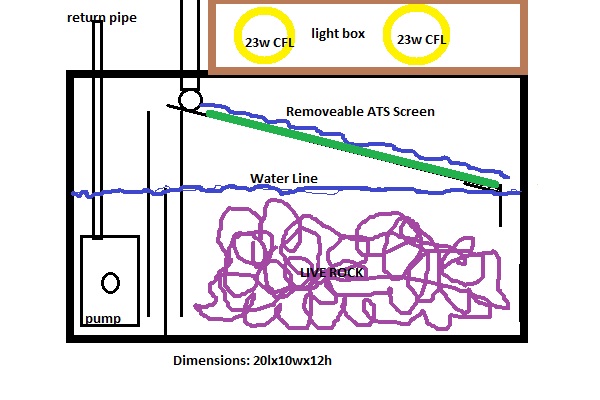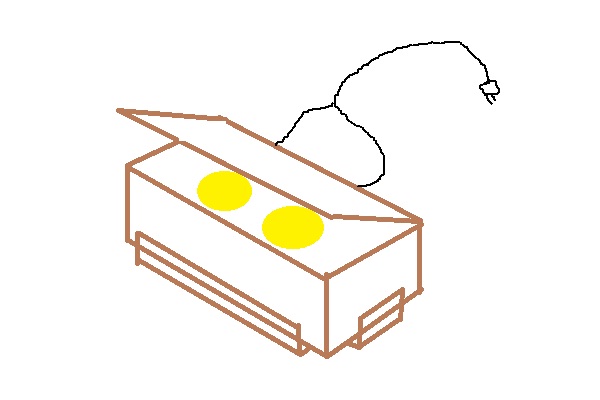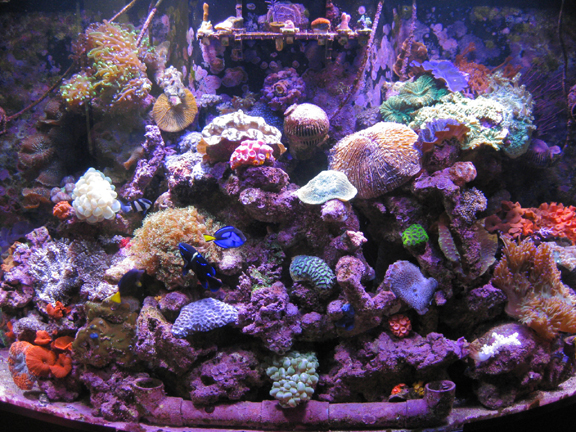snakeblitz33
Well-Known Member
So, I have been thinking about remodeling my 10g sump for my 20g reef tank. I have been doing a heck of a lot of research on algae turf scrubbers, hence ATS Sump. I'm not going to debate anyone on the use or non-use of a turf algae scrubber, because I have seen the wonderful effects first hand and I love them. I am not a fan of skimmers, so I believe I have found a great replacement.
For this build, I am going to have to re-do all of the plumbing and take a razor blade to my sump to re-arrange everything. I am going to purchase new glass baffles for this project as well. So, first take a look at the simple design and read the entire description first.

So, I measured out how big my pump is and I figure I need about 8" of pump room with the baffles. That leaves 12" worth of screen room, minus one inch for water to flow off of it. So the screen itself will be 9.75" wide by 11" long. This screen has 107.25 square inches worth of screen to use for filtration. From what I am reading, a horizontal ATS needs 4x the amount of surface room as a double sided verticle ATS to get the same amount of filtration. So, I took that 107.25 and divided it by 4 to get 26.81. That number represents the number of gallons that particular screen can handle. Since this will be on a 20g tank, I believe I have an adequate amount of screen for this setup. This particular calculation does not count the additional screen/glass used for the angle of the screen.
The screen will be made out of plastic canvas found at any hobby/sewing/craft shot. I am going to take a hole saw to scratch/rough up the entire screen. I am also going to be double screening it to make it even more rough to get the algae to hold on really well. The plastic canvas will be super glue gelled entirely to the glass. Remember, the glass being used for the ATS will be completely removable. If you notice, the ATS glass actually has a "lip" on it so it will be easily removable.
As for water flow, I calculate that the amount of water coming from my return pump down the overflow is 187gph, which is a little less than adequate for the operation of the ATS, however additional flow can be provided via powerhead from the return pumps chamber if deemed completely inadequate.
Live rock rubble will be placed below the screen, so that the water from the screen can pass through it for additional filtration. I am actually considering adding a small powerhead to the bottom of this sump so that detritus can be stirred up and returned back into the display tank.
So, that is the description. Let me know what you think - and if you run a horizontal ATS and have any experience with it's operation, please chime in!
For this build, I am going to have to re-do all of the plumbing and take a razor blade to my sump to re-arrange everything. I am going to purchase new glass baffles for this project as well. So, first take a look at the simple design and read the entire description first.

So, I measured out how big my pump is and I figure I need about 8" of pump room with the baffles. That leaves 12" worth of screen room, minus one inch for water to flow off of it. So the screen itself will be 9.75" wide by 11" long. This screen has 107.25 square inches worth of screen to use for filtration. From what I am reading, a horizontal ATS needs 4x the amount of surface room as a double sided verticle ATS to get the same amount of filtration. So, I took that 107.25 and divided it by 4 to get 26.81. That number represents the number of gallons that particular screen can handle. Since this will be on a 20g tank, I believe I have an adequate amount of screen for this setup. This particular calculation does not count the additional screen/glass used for the angle of the screen.
The screen will be made out of plastic canvas found at any hobby/sewing/craft shot. I am going to take a hole saw to scratch/rough up the entire screen. I am also going to be double screening it to make it even more rough to get the algae to hold on really well. The plastic canvas will be super glue gelled entirely to the glass. Remember, the glass being used for the ATS will be completely removable. If you notice, the ATS glass actually has a "lip" on it so it will be easily removable.
As for water flow, I calculate that the amount of water coming from my return pump down the overflow is 187gph, which is a little less than adequate for the operation of the ATS, however additional flow can be provided via powerhead from the return pumps chamber if deemed completely inadequate.
Live rock rubble will be placed below the screen, so that the water from the screen can pass through it for additional filtration. I am actually considering adding a small powerhead to the bottom of this sump so that detritus can be stirred up and returned back into the display tank.
So, that is the description. Let me know what you think - and if you run a horizontal ATS and have any experience with it's operation, please chime in!


